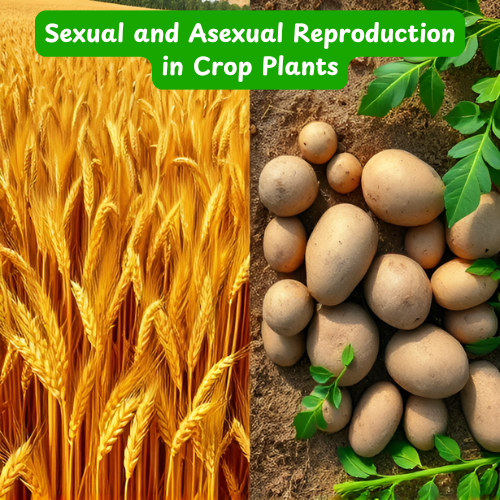Table of Contents
Introduction
The distinction between sexual and asexual reproduction in crop plants represents one of the most fundamental aspects of agricultural science. Throughout human history, our understanding of plant reproduction has shaped civilizations, influenced food security, and continues to impact modern breeding programs.
Plant reproduction strategies determine not only how we propagate crops but also influence genetic diversity, adaptation potential, and even the economic viability of agricultural systems. With global challenges like climate change and population growth increasing pressure on food production systems, understanding these reproductive mechanisms has never been more critical.
The Fundamentals of Plant Reproduction
Plants, unlike animals, have evolved remarkably diverse reproductive strategies that allow them to propagate in various environments.
Plant Reproductive Structures
The reproductive organs of plants are typically found in flowers or cones. In flowering plants (angiosperms), which include most of our food crops, the flower contains both male and female reproductive structures:
- Stamens: The male reproductive organs, consisting of an anther (which produces pollen) and a filament.
- Pistil: The female reproductive organ, comprising the stigma (which receives pollen), style, and ovary (which contains ovules).
In gymnosperms (such as conifers), reproduction occurs in cones rather than flowers, but the basic principle of male and female structures remains.

Sexual Reproduction in Crop Plants
Sexual reproduction in crop plants involves the fusion of male and female gametes, resulting in offspring with genetic contributions from both parents. This process is fundamental to plant breeding and has been the primary means of crop improvement throughout agricultural history.
The Process of Sexual Reproduction
The sexual reproduction process in flowering crop plants typically follows these steps:
- Pollination: The transfer of pollen (containing male gametes) from the anther to the stigma.
- Fertilization: The fusion of the male gamete with the female egg cell within the ovule.
- Seed Development: The fertilized ovule develops into a seed containing the embryo of the new plant.
- Seed Dispersal: Seeds are dispersed by various means, including wind, water, and animals.
- Germination: Under favorable conditions, the seed germinates to produce a new plant.
Types of Pollination in Crop Plants
When discussing sexual vs. asexual reproduction in crop plants, it’s important to understand the different pollination mechanisms:
- Self-pollination: Occurs when pollen transfers from the anther to the stigma of the same flower or different flowers on the same plant. Crops like wheat, rice, and peanuts are primarily self-pollinating.
- Cross-pollination: Involves the transfer of pollen from one plant to another. Crops like corn, rye, and many fruit trees are cross-pollinating.
- Artificial pollination: Human-mediated pollination, often used in plant breeding programs or when natural pollinators are absent.
Advantages of Sexual Reproduction in Crops
Sexual reproduction offers several significant benefits for crop plants:
- Genetic diversity: Combining genetic material from two parents creates unique offspring, promoting adaptation to changing environments.
- Evolutionary advantage: Genetic recombination allows for natural selection and adaptation over generations.
- Disease resistance: Diverse populations are less susceptible to widespread disease outbreaks.
- Breeding opportunities: Enables the development of new varieties with desired traits through controlled crosses.
Challenges of Sexual Reproduction in Agriculture
Despite its advantages, sexual reproduction presents certain challenges in agricultural settings:
- Unpredictable outcomes: Offspring may not retain all the desirable traits of parent plants.
- Time-consuming: Multiple generations may be needed to stabilize desired traits.
- Resource-intensive: Breeding programs require significant time, space, and expertise.
- Compatibility issues: Not all desirable plants can be successfully crossed.
Asexual Reproduction in Crop Plants
Asexual reproduction represents an alternative strategy where new plants develop from a single parent without the involvement of gametes or fertilization. This approach to plant propagation has been utilized by farmers for thousands of years and continues to play a crucial role in modern agriculture.
Natural Methods of Asexual Reproduction
Many crop plants have evolved natural mechanisms for asexual reproduction:
- Vegetative propagation: Plants reproduce using vegetative parts rather than seeds:
- Runners/stolons: Horizontal stems that grow along the ground and produce new plants at nodes (strawberries, mint)
- Rhizomes: Underground stems that produce new shoots (ginger, turmeric, bamboo)
- Tubers: Enlarged underground storage stems (potatoes, yams)
- Bulbs: Underground storage structures with shortened stems (onions, garlic)
- Corms: Vertical underground stems with storage tissues (taro, gladiolus)
- Apomixis: A form of asexual reproduction where seeds are produced without fertilization, essentially creating clones of the mother plant (some citrus varieties, dandelions).
Artificial Methods of Asexual Reproduction
‘In agricultural settings, humans have developed various techniques to facilitate asexual reproduction:
- Cuttings: Segments of stems, roots, or leaves are removed and encouraged to develop into new plants.
- Grafting: Tissue from one plant (scion) is inserted into another plant (rootstock) to create a composite plant.
- Layering: Stems are bent to the ground and covered with soil, encouraging them to form roots before being separated from the parent plant.
- Tissue culture: Plant cells or tissues are grown in artificial media under sterile conditions to produce numerous identical plants.
- Micropropagation: Advanced tissue culture techniques to rapidly multiply plants under controlled laboratory conditions.
Advantages of Asexual Reproduction in Agriculture
When considering sexual vs. asexual reproduction in crop plants, asexual methods offer several distinct advantages:
- Genetic uniformity: All offspring are genetically identical to the parent plant, ensuring consistency in desirable traits.
- Rapid multiplication: Many asexual methods allow for faster propagation than sexual reproduction.
- Preservation of hybrid vigor: Hybrid plants that would lose their special characteristics through sexual reproduction can be maintained through asexual means.
- Elimination of pollination requirements: Useful for plants with pollination issues or in areas with limited pollinators.
- Earlier maturity: Many asexually propagated plants reach maturity faster than those grown from seed.
Limitations of Asexual Reproduction
Despite its benefits, asexual reproduction has several limitations:
- Limited genetic diversity: Populations of cloned plants lack genetic variation, potentially making them vulnerable to diseases or environmental changes.
- Disease transmission: Pathogens can be easily transmitted through vegetative material.
- Space and resource requirements: Some methods require significant space, materials, or technical expertise.
- Storage challenges: Vegetative propagules often can’t be stored as long or as easily as seeds.
Comparing Sexual and Asexual Reproduction
A direct comparison of sexual vs. asexual reproduction in crop plants reveals the distinct advantages and disadvantages of each approach, helping farmers and breeders make informed decisions about propagation methods.
Genetic Diversity Comparison
| Aspect | Sexual Reproduction | Asexual Reproduction |
| Genetic variation | High – new combinations of genes in each offspring | Low – offspring are genetically identical to parent |
| Adaptation potential | Better equipped to adapt to changing environments | Limited adaptation without human intervention |
| Evolutionary potential | Enables natural selection and evolution | Minimal evolutionary change over generations |
| Vulnerability to diseases | Generally more resistant to widespread disease | Potentially vulnerable to diseases that affect the specific genotype |
Practical Agricultural Considerations
| Factor | Sexual Reproduction | Asexual Reproduction |
| Time to maturity | Generally longer | Often faster |
| Uniformity of crop | Variable | Highly uniform |
| Resource requirements | Seeds, pollination | Specific plant parts, sometimes specialized equipment |
| Propagation speed | Typically slower | Often faster |
| Storage capabilities | Seeds often store well | Vegetative materials often less storable |
| Cost effectiveness | Varies by crop | Varies by method and crop |
Decision Factors for Farmers
When choosing between sexual and asexual reproduction methods, farmers typically consider:
- Crop type: Some crops naturally favor one method over the other.
- Growing conditions: Environmental factors may influence reproductive success.
- Market demands: Uniformity requirements for commercial markets.
- Available resources: Access to technology, expertise, and materials.
- Time constraints: Production schedules and seasonal considerations.
- Disease management: Prevalence of seed-borne versus vegetative-borne pathogens.






